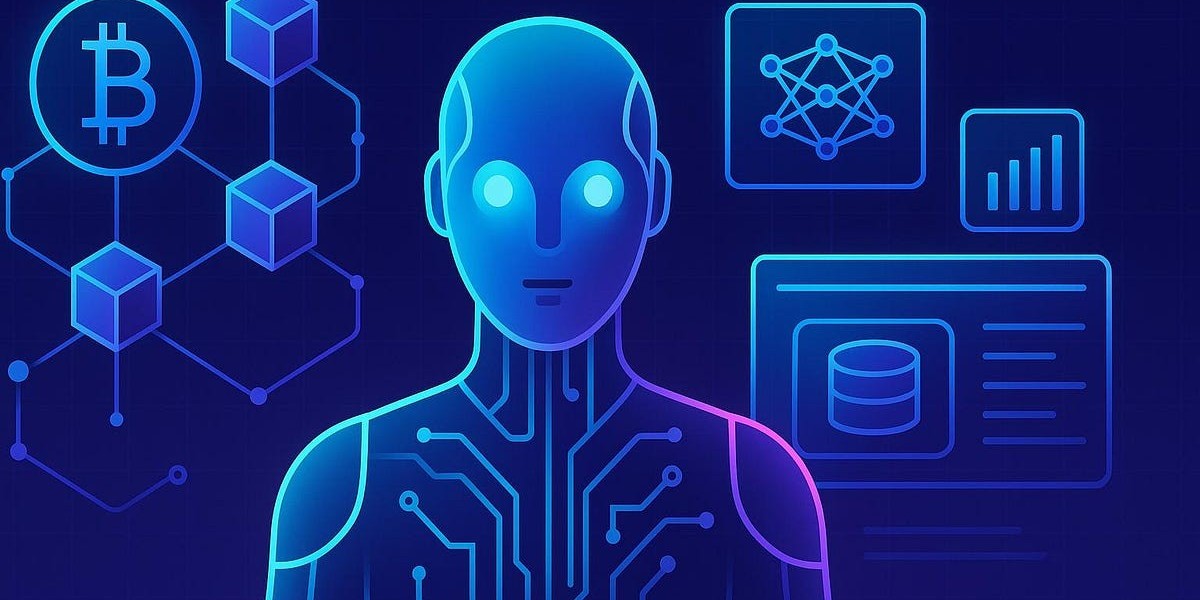The idea of smart contracts has already transformed how transactions, agreements, and decentralized systems work. They removed intermediaries and replaced trust with code. But now, a new transformation is underway—combining artificial intelligence (AI) with blockchain to create autonomous tokens capable of learning, adapting, and making data-driven decisions. This next stage of crypto token development is not just about executing code on a blockchain; It's about building systems that think and respond dynamically to their environment.
The Shift from Static to Intelligent Smart Contracts
Smart contracts today follow predefined conditions—if one condition is met, another action happens. This deterministic structure is powerful but limited. It doesn't allow contracts to evolve with changing data, user behavior, or market dynamics. For example, a staking contract might distribute rewards at a fixed rate regardless of real-time network activity or volatility.
By integrating AI into smart contracts, developers can move from static logic to adaptive intelligence. Imagine a decentralized insurance contract that automatically adjusts premiums based on live risk data, or a liquidity pool that rebalances itself based on predictive analytics. These systems do not rely solely on manual governance or fixed parameters—they can self-regulate through continuous learning models.
This is where the concept of AI-powered smart contracts comes into play. These contracts leverage machine learning algorithms, data feeds, and decision-making frameworks to act independently and intelligently, bridging the gap between automation and adaptation.
The Core Architecture of Autonomous Tokens
The architecture behind autonomous tokens revolves around integrating AI capabilities into blockchain-based systems without compromising decentralization. While AI systems typically rely on off-chain computation, the goal is to enable smart contracts to receive, process, and react to insights generated by AI in a secure and verifiable way.
The architecture usually consists of several layers that work together:
1. On-Chain Contract Layer
This layer houses the main smart contract logic, deployed on a blockchain such as Ethereum, Solana, or Polygon. It defines the fundamental token behavior—issuance, transfers, staking, and governance mechanisms. In crypto token development, this layer remains immutable after deployment, ensuring trust and transparency.
However, when AI comes into play, this on-chain layer must be designed to receive external data in a verifiable format. That's where oracles and AI agents come in.
2. Off-Chain AI Engine
AI models cannot run directly on the blockchain due to computational limits. Instead, they operate off-chain. This layer is responsible for processing vast datasets—market prices, social signals, user interactions, and environmental factors. It uses trained machine learning models or reinforcement learning algorithms to identify patterns or predict outcomes.
The off-chain AI engine then communicates insights to the on-chain layer through oracles or decentralized messaging systems. For instance, an AI model may analyze transaction patterns and send a signal to a contract to adjust a token's emission rate or modify reward distribution dynamically.
3. Oracle and Bridge Layer
AI insights must be trusted before they influence any blockchain state. Oracles act as secure bridges that feed data or predictions from the off-chain world into the on-chain environment. This layer ensures that only authenticated, verifiable, and tamper-proof data influences smart contracts.
Some modern token development companies are already working on modular oracle frameworks that not only deliver data but also validate AI outputs using consensus mechanisms, preventing manipulation and maintaining system integrity.
4. Governance and Learning Feedback Loop
Autonomous tokens often include a feedback mechanism. This loop enables the AI model to improve over time through reinforcement learning or crowd-validated outcomes. For example, if a token's liquidity adjustment model performs well, the system reinforces those parameters. If not, it adjusts the strategy automatically.
This feedback system introduces a new form of governance—algorithmic governance—where token behavior evolves not through votes alone but through data-driven feedback. It doesn't replace human decision-making but enhances it by making the system more adaptive and efficient.
Real-World Scenarios for AI-Powered Smart Contracts
The fusion of AI and blockchain is not theoretical anymore. Developers are already experimenting with a wide range of applications that extend beyond simple token transfers. Each example demonstrates how intelligence can enhance reliability, fairness, and responsiveness in decentralized ecosystems.
Autonomous Financial Protocols
AI-driven DeFi protocols can automatically rebalance liquidity pools or predict yield performance based on market volatility. Instead of static annual percentage yields, interest rates can shift dynamically based on AI-generated insights. This helps maintain stability and fairness while reducing reliance on centralized control.
Predictive Tokenomics
Traditional tokenomics rely on hardcoded supply and distribution rules. Autonomous tokens introduce a layer of adaptability, allowing emission rates, staking rewards, or burn mechanisms to change in response to on-chain data and user behavior. For instance, an AI model might predict network congestion or inflationary pressure and adjust token circulation accordingly.
Smart Governance Models
Decentralized autonomous organizations (DAOs) can incorporate AI-driven voting recommendations or proposal analysis. Instead of community members sifting through large data sets, AI agents can summarize proposal impacts, detect anomalies, and suggest optimized governance outcomes. This reduces inefficiencies and bias in decision-making.
On-Chain Reputation and Identity Systems
AI models can assess transaction histories, behavioral patterns, and social evidence to generate decentralized reputation scores. These scores can be used for credit assessments, loan approvals, or network participation rights—all managed by autonomous tokens and smart contracts.
Sustainable Supply Chains
In supply chain management, smart contracts can integrate AI to track goods, verify authenticity, and optimize logistics. AI systems can monitor environmental or market data and trigger contract actions such as payments or alerts automatically when predefined conditions are met.
Key Challenges in Building AI-Enabled Contracts
While the potential of autonomous tokens is huge, the journey is complex. Building reliable AI-integrated blockchain systems requires addressing several technical and operational challenges.
1. Computational and Storage Constraints
Blockchains are not designed for heavy computation. Executing AI models on-chain would be inefficient and expensive due to gas costs and processing limitations. This is why off-chain computation and trusted oracles are essential. Designing this interaction securely is one of the hardest tasks for any token development company working in this space.
2. Data Reliability
AI systems rely on accurate and timely data. Any tampered or biased input can mislead the system and trigger incorrect actions. Ensuring data integrity through decentralized data feeds and consensus-based oracles is crucial to maintaining trust.
3. Model Transparency
AI models often function as black boxes, making it hard to understand their reasoning. In blockchain ecosystems, transparency is vital. Developers are now focusing on interpretable AI models that allow users to verify decisions, ensuring alignment with decentralization principles.
4. Security and Adversarial Attacks
Combining blockchain with AI increases the attack surface. Malicious actors might attempt to feed manipulated data to influence AI outputs. To counter this, developers must implement cryptographic verification, multi-source validation, and reputation-based oracle systems to prevent single-point vulnerabilities.
5. Regulatory and Ethical Considerations
As autonomous tokens begin making decisions that affect value distribution or governance, ethical and legal questions arise. Should an AI-driven contract be held accountable for financial loss? How does one ensure fairness and non-discrimination in algorithmic outcomes? These are not just technical questions—they define the social responsibility of crypto token development.
How Token Development Companies Are Adapting
To keep up with this new wave of innovation, token development companies are shifting their focus from simple token creation to building full ecosystems where AI, blockchain, and data science coexist.
Modern development teams now include AI engineers alongside smart contract developers and cryptographers. The process involves designing intelligent contract architectures that can process inputs, learn from feedback, and make verified decisions through external computation frameworks.
Instead of launching static ERC-20 or BEP-20 tokens, projects are beginning to deploy AI-powered autonomous tokens that evolve with user engagement and market behavior. These companies also experiment with modular design patterns that allow developers to upgrade or plug in new AI models without redeploying entire smart contracts, preserving decentralization while allowing flexibility.
In practice, this means developing adaptable contract templates that integrate with AI APIs, decentralized storage systems, and oracle networks. The goal is to provide future-proof token frameworks capable of handling dynamic logic, predictive analytics, and autonomous actions without compromising blockchain integrity.
The Role of AI in Token Governance
Traditional token governance revolves around proposals and voting. However, this process can be slow, fragmented, and prone to manipulation. With AI, governance becomes more analytical and responsive.
AI agents can evaluate the economic impact of proposals, detect patterns in voting behavior, and identify potential conflicts of interest. Over time, they can even suggest governance improvements based on historical outcomes. For decentralized networks with thousands of participants, this level of automation can dramatically improve decision quality and speed.
By integrating reinforcement learning models, governance systems can evolve to reflect the most efficient decision-making strategies. Instead of static governance parameters, the system learns what works best, ensuring that community decisions remain aligned with the network’s long-term objectives.
Economic Models for Autonomous Tokens
One of the most exciting aspects of AI-driven token development is how it reshapes token economics. Autonomous tokens can dynamically balance supply, demand, and utility. For instance, instead of setting a fixed inflation rate, an AI model could adjust token minting based on active wallets, transaction volumes, or external indicators like market liquidity.
Such systems can maintain equilibrium without frequent human intervention. They can also prevent speculative manipulation by automatically detecting abnormal market behavior and adjusting token mechanics accordingly.
This concept introduces a new layer of algorithmic equilibrium, where tokenomics are no longer a static whitepaper specification but a continuously evolving system. The ability to self-regulate makes these tokens more resilient and adaptive in volatile markets.
Bringing AI to DeFi: Practical Integration
The intersection of AI and DeFi (Decentralized Finance) represents one of the most immediate and practical applications for autonomous tokens. In lending, for example, AI can evaluate borrower risk profiles by analyzing wallet activity, repayment behavior, and transaction data. This can make decentralized credit markets more efficient and secure.
In trading protocols, AI-powered bots can operate directly through on-chain contracts, executing trades or adjusting liquidity positions autonomously. Because the logic is encoded in verified contracts, users can trust that AI decisions follow predefined, transparent rules without centralized interference.
Some development teams are also exploring AI-curated portfolio tokens—autonomous funds that rebalance based on data-driven strategies, allowing users to hold tokens that automatically optimize their asset allocation.
Future Outlook: Autonomous Economies
The long-term vision of AI-powered smart contracts leads to the idea of autonomous economies—networks of interacting agents, tokens, and protocols that operate without continuous human oversight. These systems could negotiate, trade, and collaborate automatically, forming digital micro-economies within the broader Web3 landscape.
For example, an AI-driven energy token could manage renewable energy distribution, adjusting pricing and usage based on real-time demand. Similarly, an AI-governed charity token could allocate funds based on transparent, data-driven impact assessments. These are not speculative dreams—they represent the natural evolution of programmable money and intelligent systems.
As this vision takes shape, the line between blockchain automation and machine intelligence will blur. The next decade could see crypto token development evolving from basic digital assets into intelligent economic agents capable of independent operation and reasoning.
Conclusion
The convergence of AI and blockchain is setting the stage for the next major leap in decentralized innovation. AI-powered smart contracts mark the beginning of a new era where tokens are not just programmable—they are intelligent, adaptive, and capable of making informed decisions.
This transformation is already influencing how token development company design and deploy blockchain solutions. It demands new skill sets, architectures, and ethical frameworks but also opens opportunities to build systems that can manage themselves more efficiently than ever before.
Autonomous tokens represent more than a technological upgrade—they embody the future of decentralized intelligence. As AI models become more sophisticated and blockchain infrastructure more scalable, these intelligent systems could redefine how we build, govern, and interact with digital economies.
The world of blockchain started with automation. Its next chapter will be about intelligence.








